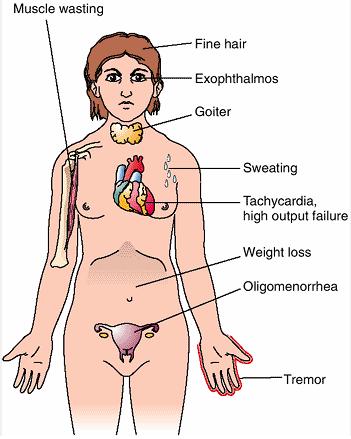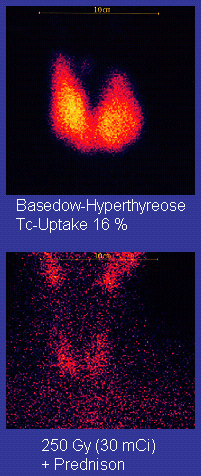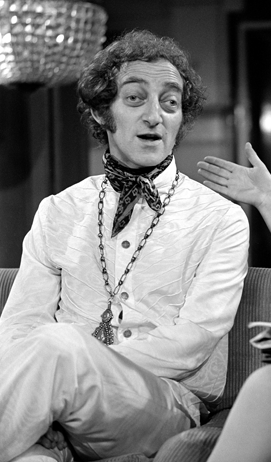Graves' Disease
Graves' disease, also known as toxic diffuse goitre or Basedow’s disease, is an autoimmune condition that affects the thyroid gland, leading to hyperthyroidism. It is the most common cause of hyperthyroidism and often results in an enlarged thyroid. The condition predominantly affects women and typically presents between the ages of 40 and 60.
Graves' disease owes its name to Robert Graves, who first described it in 1835, although other early descriptions exist.

Signs and Symptoms
The symptoms of Graves' disease primarily result from hyperthyroidism, although some symptoms are specific to the autoimmune nature of the disease, such as Graves' ophthalmopathy and pretibial myxedema. Common symptoms include irritability, muscle weakness, insomnia, rapid heartbeat, poor heat tolerance, weight loss despite increased appetite, and frequent bowel movements.
Physical signs often include a diffusely enlarged, non-tender thyroid gland, hand tremors, and arrhythmias like sinus tachycardia.

Diagnosis
Graves' disease can be suspected based on clinical symptoms and confirmed with laboratory tests. Blood tests typically reveal elevated levels of free T3 and T4 hormones and suppressed TSH levels. Additionally, thyroid-stimulating immunoglobulin (TSI) antibodies can be detected.
Radioiodine uptake tests and thyroid ultrasound with Doppler may further aid in the diagnosis.
Mechanism
The disease mechanism involves thyroid-stimulating immunoglobulins (TSI) that bind to the thyroid-stimulating hormone receptor (TSHr) on thyroid follicular cells, leading to excessive production of thyroid hormones (T3 and T4). This results in hyperthyroidism and goitre.
The autoimmune response may also affect the extraocular muscles, leading to eye bulging (exophthalmos), and cause thickening of the skin on the shins (pretibial myxedema).

Treatment
Antithyroid Drugs
Antithyroid medications like methimazole and propylthiouracil are commonly used to manage Graves' disease. These drugs inhibit iodine binding and iodotyrosine coupling, essential steps in thyroid hormone production. However, they carry risks such as agranulocytosis and liver disease, and the hyperthyroid state may recur after cessation of treatment.
Radioiodine Therapy
Radioiodine (I-131) therapy is a common treatment in the United States. It involves administering radioactive iodine, which is selectively taken up by the thyroid gland, leading to gradual destruction of thyroid tissue. This often results in hypothyroidism, which is managed by synthetic thyroid hormone replacement.

Surgery
Thyroidectomy, the surgical removal of the thyroid gland, is another treatment option, especially for those who cannot tolerate antithyroid drugs or radioiodine therapy, and in cases of large goitre or suspected malignancy. Preoperative treatment with antithyroid drugs is necessary to render the patient euthyroid. Risks of surgery include recurrent laryngeal nerve injury and hypoparathyroidism.
Eye Disease Management
Graves' ophthalmopathy may require additional treatments. Mild cases can be managed with lubricant eye drops, while severe cases may need steroids or orbital decompression surgery. Smoking cessation is very important as it can exacerbate eye symptoms.
Prognosis
If untreated, Graves' disease can lead to serious complications, including atrial fibrillation, stroke, and osteoporosis. Severe ophthalmopathy may result in vision loss. However, with appropriate treatment, these risks can be minimised, and patients can lead a normal life.
Epidemiology

Graves' disease affects approximately 0.5% of the population, with a higher prevalence in women. It accounts for 50-80% of hyperthyroidism cases in the United States.
History
The disease is named after Robert Graves, who described it in 1835. It is also known by other names such as Basedow disease in Europe and has been referred to by other names historically, including Parry disease and Flajan disease.

Self-assessment MCQs (single best answer)
What is the primary cause of hyperthyroidism in Graves' disease?
Which age group is most commonly affected by Graves' disease?
What specific physical sign is often associated with Graves' ophthalmopathy?
Which diagnostic test confirms the presence of thyroid-stimulating immunoglobulins (TSI)?
What is the most common treatment for Graves' disease in the United States?
Which of the following symptoms is NOT typically associated with hyperthyroidism in Graves' disease?
What is the main risk associated with radioiodine therapy for Graves' disease?
Which medication is commonly used to manage mild cases of Graves' ophthalmopathy?
What is the purpose of preoperative treatment with antithyroid drugs before thyroidectomy?
Which historical figure is Graves' disease named after?
Dentaljuce
Dentaljuce provides Enhanced Continuing Professional Development (CPD) with GDC-approved Certificates for dental professionals worldwide.
Founded in 2009 by the award-winning Masters team from the School of Dentistry at the University of Birmingham, Dentaljuce has established itself as the leading platform for online CPD.
With over 100 high-quality online courses available for a single annual membership fee, Dentaljuce offers comprehensive e-learning designed for busy dental professionals.
The courses cover a complete range of topics, from clinical skills to patient communication, and are suitable for dentists, nurses, hygienists, therapists, students, and practice managers.
Dentaljuce features Dr. Aiden, a dentally trained AI-powered personal tutor available 24/7 to assist with queries and provide guidance through complex topics, enhancing the learning experience.
Check out our range of courses, or sign up now!


